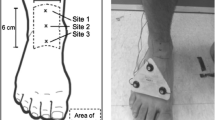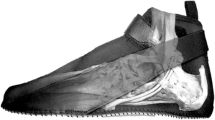Abstract
The attenuation of sensory inputs via various methods has been demonstrated to impair balance control and alter locomotor behavior during human walking; however, the effects of attenuating foot sole sensation under distinct areas of the foot sole on lower extremity motor output remains poorly understood. Thus, the purpose of this study was to attenuate cutaneous feedback via regional hypothermia under five different areas of the foot sole and investigate the resultant modulation of kinematic and muscle activity during level walking. Electromyography from eight lower leg muscles, kinematics, and location of center of pressure was recorded from 48 healthy young adults completing walking trials with normal and reduced cutaneous sensation from bilateral foot soles. The results of this study highlight the modulatory response of the tibialis anterior in terminal stance (propulsion and toe-off) and medial gastrocnemius muscle throughout the entire stance phase of gait. The topographical organization of foot sole skin in response to the attenuation of cutaneous feedback from different areas of the foot sole significantly modified locomotor activity. Furthermore, the locomotor response to cutaneous attenuation under the same regions that we previously facilitated with tactile feedback do not oppose each other, suggesting different physiological changes to foot sole skin generate unique gait behaviors.






Similar content being viewed by others
Data availability
The datasets generated during and/or analyzed during the current study are available from the corresponding author on reasonable request.
References
Abraira VE, Ginty DD (2013) The sensory neurons of touch. Neuron 79:618–639. https://doi.org/10.1016/j.neuron.2013.07.051
Alfuth M, Rosenbaum D (2012) Effects of changes in plantar sensory feedback on human gait characteristics: a systematic review. Footwear Sci 4:1–22
Assländer L, Peterka RJ (2014) Sensory reweighting dynamics in human postural control. J Neurophysiol 111:1852–1864. https://doi.org/10.1152/jn.00669.2013
Billot M, Handrigan GA, Simoneau M, Teasdale N (2015) Reduced plantar sole sensitivity induces balance control modifications to compensate ankle tendon vibration and vision deprivation. J Electromyogr Kinesiol 25:155–160. https://doi.org/10.1016/j.jelekin.2014.06.003
Eils E, Nolte S, Tewes M et al (2002) Modified pressure distribution patterns in walking following reduction of plantar sensation. J Biomech 35:1307–1313. https://doi.org/10.1016/S0021-9290(02)00168-9
Eils E, Behrens S, Mers O et al (2004) Reduced plantar sensation causes a cautious walking pattern. Gait Posture 20:54–60. https://doi.org/10.1016/S0966-6362(03)00095-X
Fallon JB, Bent LR, McNulty PA, Macefield VG (2005) Evidence for strong synaptic coupling between single tactile afferents from the sole of the foot and motoneurons supplying leg muscles. J Neurophysiol 94:3795–3804. https://doi.org/10.1152/jn.00359.2005
Geffeney SL, Goodman MB (2012) How we feel: ion channel partnerships that detect mechanical inputs and give rise to touch and pain perception. Neuron 74:609–619. https://doi.org/10.1016/j.neuron.2012.04.023
Gill G, Forman DA, Bent LR, Taylor JL (2022) Location-specific cutaneous electrical stimulation of the footsole modulates corticospinal excitability to the plantarflexors and dorsiflexors during standing. Physiol Rep 10:1–15. https://doi.org/10.14814/phy2.15240
Hao J, Bonnet C, Amsalem M et al (2015) Transduction and encoding sensory information by skin mechanoreceptors. Eur J Physiol 467:109–119. https://doi.org/10.1007/s00424-014-1651-7
Hermens HJ, Freriks B, Merletti R, Stegeman D, Blok J, Rau G, Disselhorst-Klug C, Hägg G (1999) European recommendations for surface electromyography: results of the SENIAM project. Roessingh Research and Development, Enschede
Hohne A, Ali S, Stark C, Brüggemann G-P (2012) Reduced plantar cutaneous sensation modifies gait dynamics, lower-limb kinematics and muscle activity during walking. Eur J Appl Physiol 112:3829–3838. https://doi.org/10.1007/s00421-012-2364-2
Lowrey CR, Strzalkowski NDJ, Bent LR (2013) Cooling reduces the cutaneous afferent firing response to vibratory stimuli in glabrous skin of the human foot sole. J Neurophysiol 109:839–850. https://doi.org/10.1152/jn.00381.2012
Macefield VG (1998) The signaling of touch, finger movements and manipulation forces by mechanoreceptors in human skin. In: Morley JW (ed) Neural aspects of tactile sensation. Elsevier Science Publishers, Amsterdam, pp 89–130
McDonnell M, Warden-Flood A (2000) Effect of partial foot anaesthesia on normal gait. Aust J Physiother 46:115–120. https://doi.org/10.1016/S0004-9514(14)60319-6
McGlone F, Reilly D (2010) The cutaneous sensory system. Neurosci Biobehav Rev 34:148–159. https://doi.org/10.1016/j.neubiorev.2009.08.004
Mckeon P, Hertel J (2007) Diminished plantar cutaneous sensation and postural control. Percept Mot Skills 104:56–66
Nakajima T, Sakamoto M, Tazoe T, Endoh T (2006) Location specificity of plantar cutaneous reflexes involving lower limb muscles in humans. Exp Brain Res 175:514–525. https://doi.org/10.1007/s00221-006-0568-6
Nurse MA, Nigg BM (2001) The effect of changes in foot sensation on plantar pressure and muscle activity. Clin Biomech 16:719–727. https://doi.org/10.1016/S0268-0033(01)00090-0
Nurse MA, Hulliger M, Wakeling JM et al (2005) Changing the texture of footwear can alter gait patterns. J Electromyogr Kinesiol 15:496–506. https://doi.org/10.1016/j.jelekin.2004.12.003
Perotto A (2011) Anatomical guide for the electromyographer - the limbs and trunk, 5th edn. Charles C Thomas Springfield, Illinois
Perry SD, McIlroy WE, Maki BE (2000) The role of plantar cutaneous mechanoreceptors in the control of compensatory stepping reactions evoked by unpredictable, multi-directional perturbation. Brain Res 877:401–406. https://doi.org/10.1016/S0006-8993(00)02712-8
Perry SD, Radtke A, McIlroy WE et al (2008) Efficacy and effectiveness of a balance-enhancing insole. J Gerontol 63:595–602. https://doi.org/10.1093/gerona/63.6.595
Ray CT, Horvat M, Croce R et al (2008) The impact of vision loss on postural stability and balance strategies in individuals with profound vision loss. Gait Posture 28:58–61. https://doi.org/10.1016/j.gaitpost.2007.09.010
Robb KA, Perry SD (2022) The effect of texture under distinct regions of the foot sole on human locomotion. Exp Brain Res. https://doi.org/10.1007/s00221-022-06402-x
Sarabon N, Rosker J, Loefler S, Kern H (2013) The effect of vision elimination during quiet stance tasks with different feet positions. Gait Posture 38:708–711. https://doi.org/10.1016/j.gaitpost.2013.03.005
Sinkjaer T, Andersen JB, Ladouceur M et al (2000) Major role for sensory feedback in soleus EMG activity in the stance phase of walking in man. J Physiol 523:817–827
Sozzi S, Monti A, Marco A et al (2011) Sensori-motor integration during stance : time adaptation of control mechanisms on adding or removing vision. Hum Mov Sci 30:172–189. https://doi.org/10.1016/j.humov.2010.06.002
Strzalkowski NDJ, Peters RM, Inglis JT, Bent LR (2018) Cutaneous afferent innervation of the human foot sole: what can we learn from single-unit recordings? J Neurophysiol 120:1233–1246. https://doi.org/10.1152/jn.00848.2017
Strzalkowski NDJ, Ali RA, Bent LR (2019) The firing characteristics of foot sole cutaneous mechanoreceptor afferents in response to vibration stimuli. J Neurophysiol. https://doi.org/10.1152/jn.00647.2016
Taylor AJ, Menz HB, Keenan AM (2004) Effects of experimentally induced plantar insensitivity on forces and pressures under the foot during normal walking. Gait Posture 20:232–237. https://doi.org/10.1016/j.gaitpost.2003.02.001
Wang TY, Lin SI (2008) Sensitivity of plantar cutaneous sensation and postural stability. Clin Biomech 23:493–499. https://doi.org/10.1016/j.clinbiomech.2007.11.014
Winter DA (1983) Biomechanical motor patterns in normal walking. J Mot Behav 15:302–330. https://doi.org/10.1080/00222895.1983.10735302
Zehr EP, Stein RB (1999) What functions do reflexes serve during human locomotion? Prog Neurobiol 58:185–205. https://doi.org/10.1016/S0301-0082(98)00081-1
Zehr P, Nakajima T, Barss T et al (2014) Cutaneous stimulation of discrete regions of the sole during locomotion produces “sensory steering” of the foot. BMC Sports Sci Med Rehabil 6:33. https://doi.org/10.1186/2052-1847-6-33
Zimmerman A, Bai L, Ginty DD (2014) The gentle touch receptors of mammalian skin. Science 346:950–954. https://doi.org/10.1126/science.1254229
Acknowledgements
This work was supported by the Natural Science and Engineer Research Council of Canada (NSERC) Discovery Grant [RGPIN-2015-06481] and the Canadian Foundation for Innovation [5141].
Funding
This article is funded by Pedorthic Research Foundation of Canada, Natural Science and Engineer Research Council of Canada, RGPIN-2015-06481, Stephen D. Perry, Canadian Foundation for Innovation, 5141, Stephen D. Perry.
Author information
Authors and Affiliations
Corresponding author
Ethics declarations
Conflict of interest
None.
Additional information
Communicated by Francesco Lacquaniti.
Publisher's Note
Springer Nature remains neutral with regard to jurisdictional claims in published maps and institutional affiliations.
Rights and permissions
Springer Nature or its licensor (e.g. a society or other partner) holds exclusive rights to this article under a publishing agreement with the author(s) or other rightsholder(s); author self-archiving of the accepted manuscript version of this article is solely governed by the terms of such publishing agreement and applicable law.
About this article
Cite this article
Robb, K.A., Perry, S.D. The topographical attenuation of cutaneous input is modulated at the ankle joint during gait. Exp Brain Res 242, 149–161 (2024). https://doi.org/10.1007/s00221-023-06737-z
Received:
Accepted:
Published:
Issue Date:
DOI: https://doi.org/10.1007/s00221-023-06737-z




